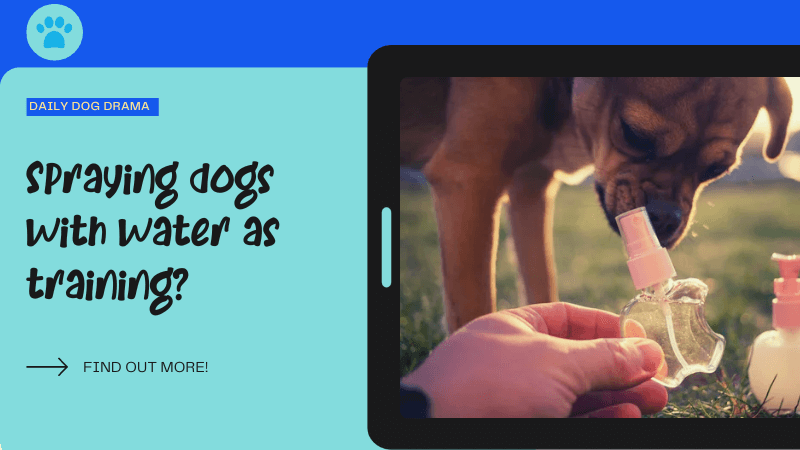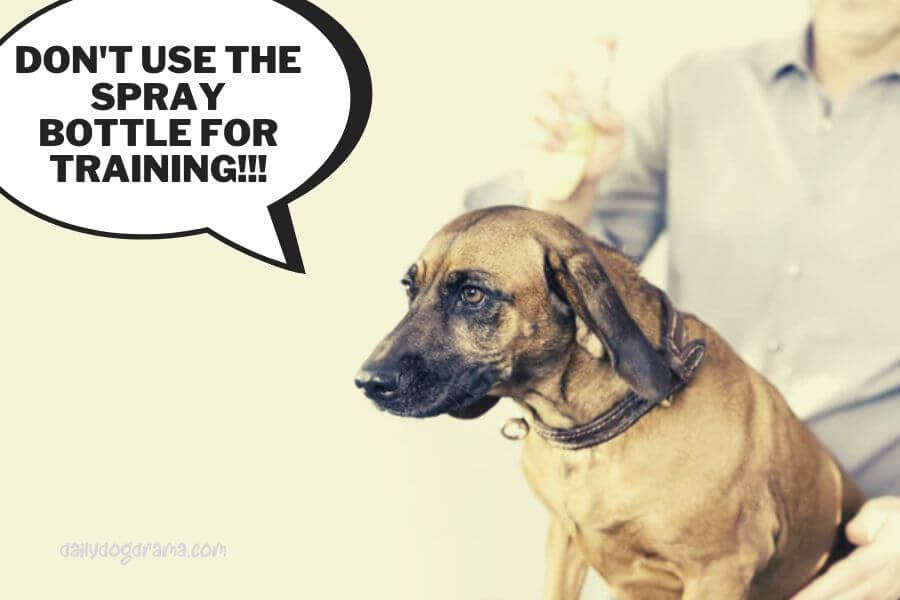Do you know what DOG ESSENTIALS you are missing out? Find out now!
Zack Keithy, our author, is a certified veterinarian technician (UC Blue Ash) for over 6 years (contact him here). The articles written here are based on his expertise and experience, combined with a review by our expert vet reviewers including Dr M. Tarantino. Learn more about us here.
It’s no secret that training a dog can be a trying experience.
Dogs are naturally curious and energetic, so it’s no wonder you sometimes feel like your head is spinning in circles when trying to keep up with them.
In some cases, we might turn to solutions that are as simple as possible to execute, but in finding a shortcut such as spraying dogs with water, are we really helping?
In this post, learn more about this method of training, if it works, and what your alternatives are.
Medical Questions? Talk to a Veterinarian 24/7.
Connect one-on-one with a licensed vet who will answer your questions in minutes.
*Article may contain affiliate links to retailers like Amazon and Chewy. Learn more on our disclosure page.

Does Spraying a Dog With Water Work?
No, using a spray bottle on your dog as a training method is ineffective.
Back in the 80s and 90s, this method was commonly used and thought to be a harmless way to stop negative behavior.
However, times have changed and science tells us otherwise.
Why Doesn’t Spraying a Dog with Water Work?
The problem with using punishment as a way of training your dog is that it does not teach the correct behavior, but instead only stops it temporarily.
The dog’s bad conduct may appear to have stopped at first, but as soon as you and the spray bottle leave the area, it returns.
It becomes an opportunity to carry on misbehaving.
There are 4 key points you need to know.
Negative association with the spray bottle
By using a spray bottle to punish and stop your dog from doing something, it starts to have a negative association with the object.
Whenever you whip it out, it will likely stop its behavior, but also display other fearful responses such as hiding
Negative association with the spray bottle toward you
Although you might think, “Great, my dog is not doing things I don’t like anymore!”, the truth might be something different.
The trust between the dog and the owner is broken, and now it starts to regard you with fear.
Every time you reach out to touch his face with your arm or hand, or whenever he notices you coming, he flees or turns away.
He does this because he believes you are going to spray water in his face.
This will kill the relationship between you and your dog.
The only thing you are teaching your dog is to be afraid of you and the spray bottle.
Doggy says, you might be interested in reading this too: Withholding water for dogs at night
Affects other water-related activities
While dogs are smart, the truth is that there is still a limit to their understanding, but the good thing is that it makes them more predictable and easier to train.
Now, if you have been using a water spray to deter your dog from doing “bad” things, how do you think it will react the next time you want to involve it in a water activity?
This can be shower time, grooming sessions (where you need to spray some water to wet its coat), or even going out for swims (which it might have loved in the past).
There is a good chance that it will avoid and shun them now, as it has associated the spray bottle, and possibly water itself, as things to be feared.
Dog’s attitude
On the contrary, a spray bottle would have the exact opposite result for a dog that loves water.
Oh, you’re spraying water at me. That’s fun!
Some dogs love water. They chase after water hoses, go crazy when the sprinklers come on, or are avid swimmers.
By using a spray bottle, you are actually positively reinforcing the negative behavior you want to change.
What is an Aversive?
An aversive is anything that causes discomfort or annoyance to a dog to stop a particular action and aversive training is the use of negative reinforcement or punishment to modify behavior.
The most common forms of aversion are spray bottles, shock collars, muzzles, and prong collars (also called pinch collars).
For example, if you give your dog a shock collar to stop it from barking, then the shock collar is aversive.
The use of spray bottles as punishment is considered a form of punishment too because it is used to stop your dog from doing something by causing discomfort.
This is the opposite of positive reinforcement, where you reward an animal for doing something good by giving it something it wants.
What Are the Downsides of Using an Aversive?
While some trainers do incorporate using aversive methods in their training, it is used sparingly and most often combined with positive reinforcement techniques.
It is also important to pay close attention to the way your dog is reacting. Some dogs might take it as something good and continue doing the action, so this method definitely does not work.
If you happen to have one of these dogs, change your approach and make sure it is working as it should.
So, anyways, the most common problem with using aversive training methods is that they don’t make the animal feel good about itself and they don’t really work for long.
If you use an aversive to stop your dog from barking, it will stop at that moment, but once you are removed from the picture, the barking will resume.
This teaches them nothing except that there is something bad after barking, but they still don’t know what else to do!
Also, this method can cause stress and anxiety in your dog as it is driven mainly by pain and fear.
This can lead to aggression and other behavioral problems.
Aversive methods can also make your dog afraid of you, which makes it difficult for you to train them or have a happy relationship with them.
If you are unsure what to do, I highly recommend that you speak to a professional dog trainer, or at least spend a considerable amount of time learning.

Doggy says, you might wanna read this too: Can dogs get swimmer’s itch?
How to Stop Undesirable Behavior in Your Dog?
Instead of using punishments to train your dog, here are a few tips you can follow to help change your dog’s undesirable behavior:
Barking
For dogs, barking is just like us humans talking.
However, there are situations when your pet’s barking becomes excessive.
They may be barking at everything in their path because they are restless or anxious.
What you can do instead is make use of a unique command such as quiet to train it, and reinforce good behavior with treats.
This should be done in the comfort of your home at first and you can progress to doing this outside when your dog shows improvement.
Chewing and biting
If your dog is chewing on everything in sight, it may be because they are bored, or possibly teething (for puppies).
You can help curb this behavior by giving them something else to do.
Spend more time playing with your pet or taking them for a walk around the neighborhood, and definitely invest in a good chew toy for it to munch on.
Jumping
Jumping up on people or furniture can be cute at first, but it can quickly become annoying.
This is especially true if you have guests over who may not be comfortable with the attention.
To help curb this behavior, you first need to teach it the command “sit”, or something similar.
Once your dog is able to understand and follow this command, everything else is much easier.
Each time it starts jumping, give it the sit command, and as soon as they sit back down, reward it with a delicious treat.
Leash pulling
Your dog has to learn that staying close to you is the right thing to do.
Reward your dog for sitting or standing by your side, first in your home or garden where it is more relaxed.
Your dog will learn new behaviors much more quickly in a calm environment where it won’t be easily distracted.
When the lead starts to tighten, stop moving. This is to teach your dog that when they follow you on a loose lead and don’t tug, they are allowed to move.
So, stop walking as soon as the lead starts to tighten and wait until the lead is slack before moving again.
A treat when it does the right thing will definitely help reinforce the right behavior.
Other negative behaviors
As you can see, the way to train your dog is somewhat similar in most situations: Redirecting them from negative actions, using consistent commands, and rewarding them with treats.
The tips above are general guidelines only, so I highly recommend that you take the time to learn more about them in order to develop a much better relationship with your dog.
Frequently Asked Questions (FAQs)
Is spraying a dog with water abuse?
It really depends very much on your own definition of abuse, but for us, we think that it is borderline abuse. Although the water sprayed from a bottle will not physically harm a dog, it can cause it to suffer mentally and develop an irrational fear.
Is it OK to spray your dog with water?
No, it is not ok to spray your dog with water as a training method. If it was done in a fun environment, it would be acceptable.
Can I spray dogs with water to stop fighting?
Yes, you can spray dogs with water to stop fighting if you do it safely. You should never stand in between two dogs that are fighting though, as this could put your own safety at risk. Never use too powerful a spray jet that can inadvertently harm the dogs, but rather as a way to startle and distract them.
Can I spray my dog with vinegar and water for training?
No, you should not use vinegar and water to train your dog. It causes a fear mentality, and if not mixed properly, can cause irritation, redness, and dryness on your dog’s skin. Also, vinegar can be harmful if it gets into the eyes of your dog.
In Conclusion: Spraying dogs with water
Using a spray bottle as a deterrent to dogs is an old and misused method for training them.
You should instead look to using positive reinforcement methods, which can help you build a meaningful and trusting relationship with your fur baby.
Consider checking out other dog care articles on our site such as umbilical hernia in dogs, overgrown dew claw, why is my puppy not eating and sleeping a lot, and many more on our blog!
You’ve made it to the end, but I hope it’s not the end of our journey. We want to hear your voice! Share your thoughts, problems, suggestions, or anything related to your dog in the comments section. And don’t forget to join our newsletter today too.



